Benin Art And Architecture - Culture (9) - Nairaland
Nairaland Forum / Nairaland / General / Culture / Benin Art And Architecture (207182 Views)
Art And Architecture Of The Igbo People / The Art And Architecture Of Yorubaland! / Show Pictures Of Africas Art And Archaeological Treasures (2) (3) (4)
(1) (2) (3) ... (6) (7) (8) (9) (10) (11) (12) ... (25) (Reply) (Go Down)
| Re: Benin Art And Architecture by PhysicsMHD(m): 6:53am On Mar 28, 2011 |
"At IGO a town on the Gilly Gilly road there is a mound on which is an altar to OLUKUN with chalk cones and cowries on it all covered by a shed. They say that EHAIZAÃI, King of Benin, because it was unhappy in Benin City, sent it to IGO. They say they knew it was unhappy because of the sickness it caused in the City. At UGWATON there is also a temple to this great spirit, or power, mentioned by Burton.[1] OLUKUN is said to have been one of the sons of God who married OHA. OHA is the river running from the town of OKHA past SILUKU into the Benin river, and forms the western and northern boundary of the Benin Kingdom dividing it from the intermediate province of ELAWWEY which is a kind of neutral province between the Benin and Yoruba Kingdoms. 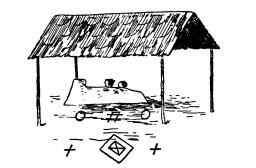 An altar to OLUKUN, under a little shed, with native pots on it. Chalk marks, as above, being made on the ground in front of it." - At the Back of the Black Man's Mind, by Richard Edward Dennett, [1906] (My own observation: in Dennett's sketch, I can see the "x" and "o" symbols amazonia mentioned earlier (page 5) in this thread). |
| Re: Benin Art And Architecture by PhysicsMHD(m): 6:58am On Mar 28, 2011 |
"AWREOMO. The sign of this river is an earthenware pot of water. At its source, not far from the town of OKHI, this river is called AKE, the axe. As a "juju" this power AKE is represented by lumps of earth, ant-hills, bits of pot, stones and chalk, which are covered by a slanting roof of bark called OKUKU. There is a large "juju house" at IDUNGENA, near Benin City. It is a building of sun-dried mud, in the form of a hollow square, with lean-tos from the top of each wall forming cloisters. Over the doorway a long bamboo, with a basket cup-like arrangement at the top, hangs like a barber's pole. This has been called OYISA, Esu, and UKHURE by different people I have asked to name it. 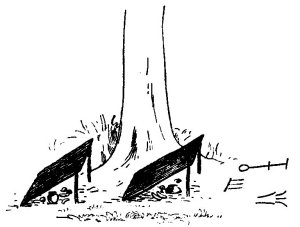 AKE. Pieces of bark supported at one end by two sticks forming a kind of lean-to shed, under which are found a pot of water, bananas, and yams. Generally found at the foot of trees with various chalk marks in front of them. (See other note.)" - At the Back of the Black Man's Mind, by Richard Edward Dennett, [1906] |
| Re: Benin Art And Architecture by PhysicsMHD(m): 7:38am On Mar 28, 2011 |
   Benin Bronze Palace Wall Plaque Ethnic Group: Edo People Country: Benin Kingdom, Nigeria Material: Bronze Size: Circa: 16th Century Status: Private Collection, USA Depiction: 3 Court Gong Players |
| Re: Benin Art And Architecture by Rossikk(m): 8:21am On Mar 28, 2011 |
ezeagu said: Logogram Those descriptions/definitions you give are wayyy too sharp. Fact is there is a lot of interloping and blurring of lines in the conceptualization and expression of the three. |
| Re: Benin Art And Architecture by ezeagu(m): 10:38pm On Mar 28, 2011 |
Rossikk: Do you have an example. |
| Re: Benin Art And Architecture by Rossikk(m): 4:14am On Mar 29, 2011 |
Excerpt: Hieroglyphic script may be divided into three categories - logograms, phonograms and determinatives (Davies, p. 102 - 105). The simplest form of hieroglyphic writing is the logogram, which is an iconic sign of the object it represents. Examples of Egyptian logograms: [img]http://csmt.uchicago.edu/glossary2004/hieroglyphics/hieroglyphics1.gif[/img] Hieroglyphic script constantly switches between icon and symbol to complicate the word/image relationship. At times, characters function as icons that represent the objects they depict. At other times, characters function as arbitrary signs, requiring the reader to assign phonetic value. The amalgamation of word and image not only makes the translation of hieroglyphics difficult, but also raises interesting questions about the characteristics of this medium. It can function archeologically, providing records of ancient Egyptian life. It can function phonetically to help linguists assemble conjectured patterns of speech. Or, its ancient symbols can simply represent esoteric art that resists translation in order to preserve the mystery of the medium. http://csmt.uchicago.edu/glossary2004/hieroglyphics.htm |
| Re: Benin Art And Architecture by ezeagu(m): 11:04pm On Mar 29, 2011 |
So do you have an example? |
| Re: Benin Art And Architecture by PhysicsMHD(m): 6:29pm On Mar 30, 2011 |
 1897 picture of palace interior and carved ivory tusks. |
| Re: Benin Art And Architecture by PhysicsMHD(m): 6:34pm On Mar 30, 2011 |
 |
| Re: Benin Art And Architecture by PhysicsMHD(m): 6:37pm On Mar 30, 2011 |
 |
| Re: Benin Art And Architecture by PhysicsMHD(m): 6:40pm On Mar 30, 2011 |
 |
| Re: Benin Art And Architecture by PhysicsMHD(m): 6:41pm On Mar 30, 2011 |
 |
| Re: Benin Art And Architecture by PhysicsMHD(m): 6:47pm On Mar 30, 2011 |
 |
| Re: Benin Art And Architecture by PhysicsMHD(m): 6:48pm On Mar 30, 2011 |
 |
| Re: Benin Art And Architecture by PhysicsMHD(m): 6:50pm On Mar 30, 2011 |
 |
| Re: Benin Art And Architecture by PhysicsMHD(m): 6:51pm On Mar 30, 2011 |
 |
| Re: Benin Art And Architecture by PhysicsMHD(m): 6:52pm On Mar 30, 2011 |
 |
| Re: Benin Art And Architecture by PhysicsMHD(m): 6:59pm On Mar 30, 2011 |
 |
| Re: Benin Art And Architecture by PhysicsMHD(m): 7:02pm On Mar 30, 2011 |
 |
| Re: Benin Art And Architecture by PhysicsMHD(m): 7:59pm On Mar 30, 2011 |
^^^^ The above caption seems inaccurate, actually. Nevertheless, it's a pretty unique and interesting plaque. |
| Re: Benin Art And Architecture by PhysicsMHD(m): 6:35pm On Apr 01, 2011 |
 [In case anyone is wondering, the Benin soldiers attached horsetails to the top of their metal helmets. Horsetails were a popular trade item between West Africans and Europeans. You can check the book Benin, Kings and Rituals: Court Art from Nigeria for more information on this type of attire.] |
| Re: Benin Art And Architecture by PhysicsMHD(m): 9:24pm On Apr 01, 2011 |
| Re: Benin Art And Architecture by PhysicsMHD(m): 10:06pm On Apr 01, 2011 |
 Posted a plaque similar to this, but actually different, a few posts above. |
| Re: Benin Art And Architecture by PhysicsMHD(m): 10:17pm On Apr 01, 2011 |
 |
| Re: Benin Art And Architecture by PhysicsMHD(m): 10:23pm On Apr 01, 2011 |
 Brass pectoral ornament with a ram's head, part of a chief's regalia. Edo culture, Nigeria |
| Re: Benin Art And Architecture by PhysicsMHD(m): 10:24pm On Apr 01, 2011 |
 |
| Re: Benin Art And Architecture by PhysicsMHD(m): 10:26pm On Apr 01, 2011 |
 This bronze is one of my personal favorites out of all the Benin art that I have seen. |
| Re: Benin Art And Architecture by PhysicsMHD(m): 10:30pm On Apr 12, 2011 |
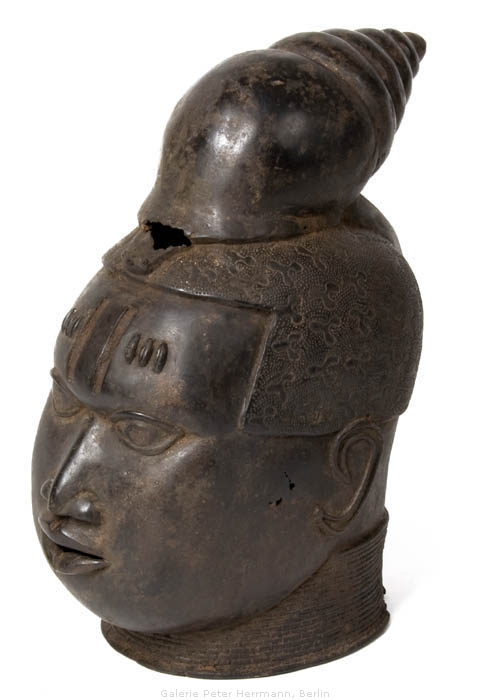 Head with Snail Benin, Nigeria About 1550 Bronze 32 cm |
| Re: Benin Art And Architecture by PhysicsMHD(m): 10:31pm On Apr 12, 2011 |
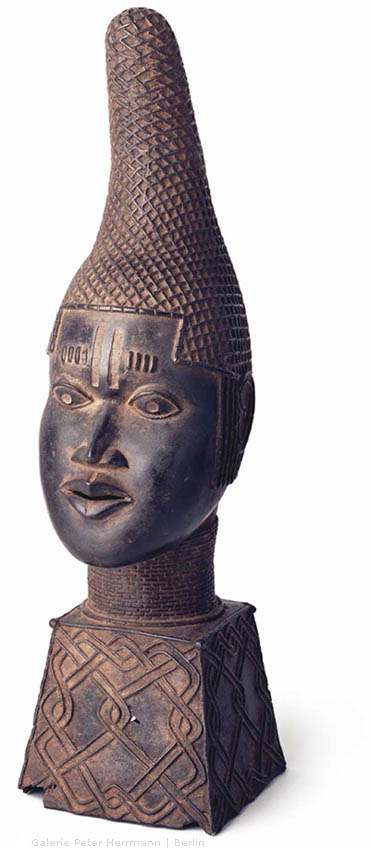 Memorial Head of a Queen Mother Benin, Nigeria 16th-17th century Bronze 55 cm The towering coral headdress is an important adornment of the so-called Queen Mother, an appellation that hearkens back to Oba Esigie, who ruled until 1550. Esigie is said to have conferred the title Iyoba (Queen Mother) upon his mother Idia out of gratefulness and respect and to have thereupon inaugurated this type of representation. Since then, all Obas have had the right to grant their mothers the official title Iyoba three years after their enthronement, though only 17 of the 38 Obas of the current dynasty have done so. In general, the Oba never again sets eyes upon his mother once he has assumed his title. As Iyoba, however, the Oba's mother is the only woman to occupy one of the highest posts in Benin, meaning that her son, the Oba, can consult with her on all matters of state. Conferring the title is thus a particularly important decision. After a Queen Mother's death, the Oba dedicates an entire altar to her to which he brings yearly sacrifices in her honour. He also erects a shrine devoted exclusively to her either in the royal palace or at the Iyoba's residence in Uselu, filling it with corresponding memorial heads. This head - unusually girl-like for the depiction of a mother - is highly idealised, suggesting that the idealised acts of enshrinement and worship were more important than actual remembrance in the form of a realistic image. Most depictions of Iyobas were based on Esigie's model and always outfitted with the following attributes: a tall, coral-adorned coiffeur, customary decorative scars on the forehead, coral neck jewellery and a pedestal decorated with wattling or fish-like ornamentation. Cp.: Paula Girshick BEN-AMOS: The art of Benin, London 1995, S. 35/ 36. Ekpo EYO, Frank Willett: Kunstschätze aus Alt-Nigeria, Mainz 1983, S. 134. Felix von LUSCHAN: Die Altertümer von Benin, Band 1, Berlin 1919, S. 356/ 357. Till Förster: Kunst in Afrika, Köln 1988, S. 110/ 111. Barbara PLANKENSTEINER (Hg.): Benin. Könige und Rituale. Höfische Kunst aus Nigeria, Wien 2007, S. 395 - 398. |
| Re: Benin Art And Architecture by PhysicsMHD(m): 10:32pm On Apr 12, 2011 |
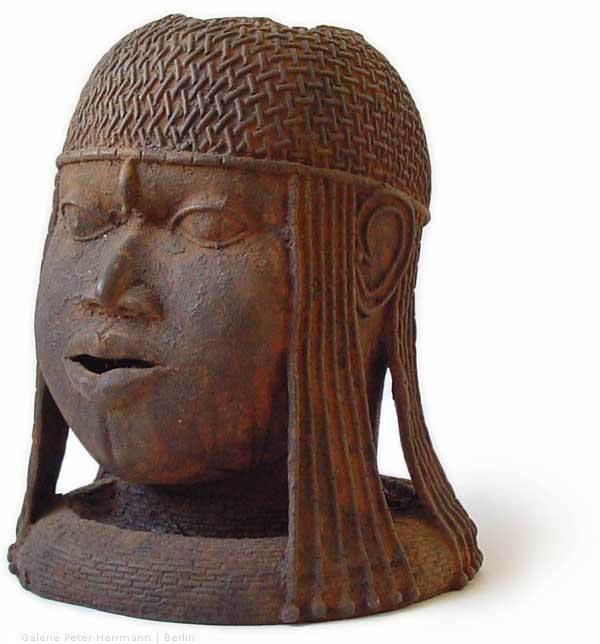 Benin, Nigeria 16th century Bronze 25 cm It is not known whom this head is meant to represent. In 1919, Luschan held it for a female head, based on the argument that such toric necklaces were worn only by female musicians. The latest research, however, indicates that this is the memorial head of a king. Copies of this head - with coral head covering, a single pearl on the forehead, toric coral necklace and hanging pearl plaits - appeared frequently during the 16 th century. The gentle modelling of the soft and sensitive facial features is noteworthy in and of itself and especially in contrast with the much more diagrammatically rendered ears. The realistic portrayal of the face is typical for Benin bronzes from the 16 th century and is usually seen as evidence of Ife influences. The question of who influenced whom and during what time period, however, has still not yet been adequately explored. Cp.: Felix von LUSCHAN: Die Altertümer von Benin, Band 1, Berlin 1919, S. 357. Philip J. C. DARK: An introduction to Benin art and technology, Oxford 1973, S. 94. Barbara PLANKENSTEINER (Hg.): Benin. Könige und Rituale. Höfische Kunst aus Nigeria, Wien 2007, S. 373. |
| Re: Benin Art And Architecture by PhysicsMHD(m): 10:34pm On Apr 12, 2011 |
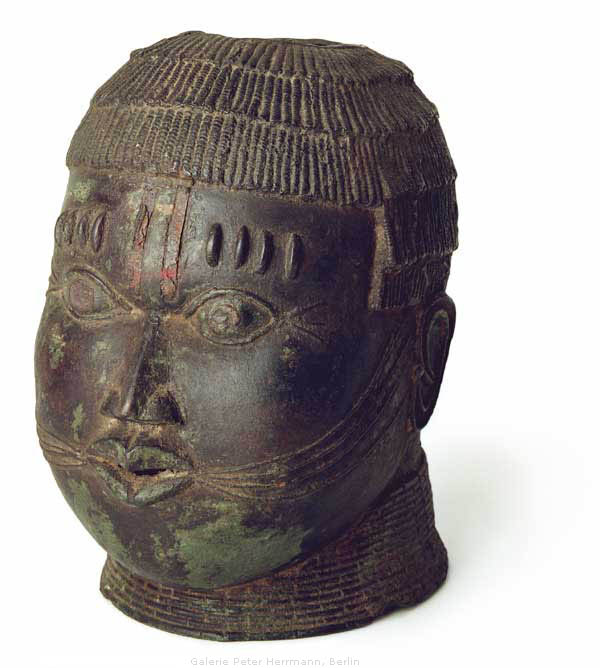 Benin, Nigeria. 16th century Bronze 23 cm |
| Re: Benin Art And Architecture by PhysicsMHD(m): 10:35pm On Apr 12, 2011 |
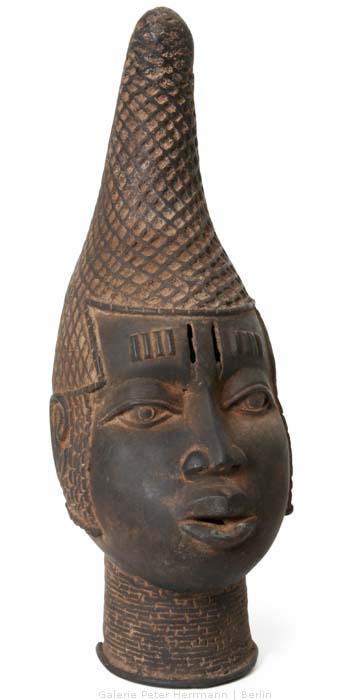 Queenmother Benin, Nigeria Bronze 47 cm |
(1) (2) (3) ... (6) (7) (8) (9) (10) (11) (12) ... (25) (Reply)
20 Popular Yoruba Charms And Their Uses(With Direct English Translations) / HAUSALAND: Teach Me Hausa / The Culture Lounge
(Go Up)
| Sections: politics (1) business autos (1) jobs (1) career education (1) romance computers phones travel sports fashion health religion celebs tv-movies music-radio literature webmasters programming techmarket Links: (1) (2) (3) (4) (5) (6) (7) (8) (9) (10) Nairaland - Copyright © 2005 - 2024 Oluwaseun Osewa. All rights reserved. See How To Advertise. 51 |